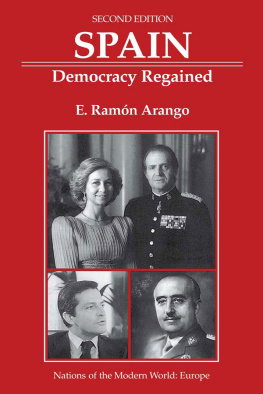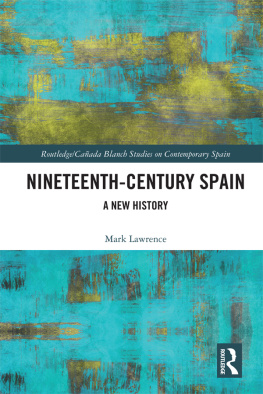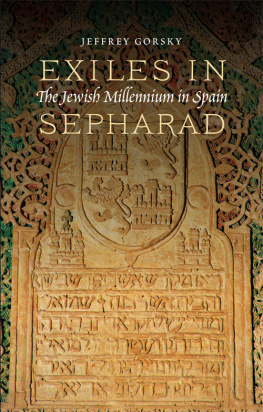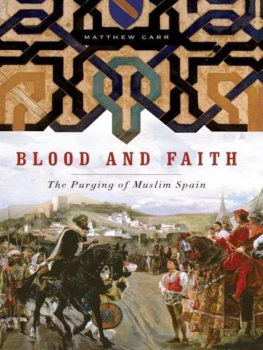ROUTLEDGE LIBRARY EDITIONS:
MUSLIM SPAIN
Volume 1
THE CID AND HIS SPAIN
THE CID AND HIS SPAIN
RAMN MENNDEZ PIDAL
First published in 1934 by John Murray
New edition published in 1971 by Frank Cass
This edition first published in 2016
by Routledge
2 Park Square, Milton Park, Abingdon, Oxon OX14 4RN
and by Routledge
711 Third Avenue, New York, NY 10017
Routledge is an imprint of the Taylor & Francis Group, an informa business
1934, 1971 Frank Cass
All rights reserved. No part of this book may be reprinted or reproduced or utilised in any form or by any electronic, mechanical, or other means, now known or hereafter invented, including photocopying and recording, or in any information storage or retrieval system, without permission in writing from the publishers.
Trademark notice: Product or corporate names may be trademarks or registered trademarks, and are used only for identification and explanation without intent to infringe.
British Library Cataloguing in Publication Data
A catalogue record for this book is available from the British Library
ISBN: 978-1-138-68295-5 (Set)
ISBN: 978-1-315-53733-7 (Set) (ebk)
ISBN: 978-1-138-68962-6 (Volume 1) (hbk)
ISBN: 978-1-138-68966-4 (Volume 1) (pbk)
ISBN: 978-1-315-53749-8 (Volume 1) (ebk)
Publishers Note
The publisher has gone to great lengths to ensure the quality of this reprint but points out that some imperfections in the original copies may be apparent.
Disclaimer
The publisher has made every effort to trace copyright holders and would welcome correspondence from those they have been unable to trace.
THE CID
AND HIS SPAIN
By RAMN MENNDEZ PIDAL
TRANSLATED
By HAROLD SUNDERLAND
FOREWORD
By THE DUKE OF BERWICK AND ALBA
LONDON
First Edition 1934
DEDICATION
THE AUTHOR AND TRANSLATOR WISH TO RECORD
THEIR GRATITUDE TO THE
DUKE OF BERWICK AND ALBA
TO WHOSE GENEROUS INITIATION THE PUBLICATION
OF THIS EDITION IS DUE
CONTENTS
CHAP.
PART I
INTRODUCTORY
PART II
THE CID OF CASTILE
PART III
THE CID BANISHED FROM CASTILE
CHAP.
PART IV
THE ALMORAVIDE INVASION
PART V
THE CID DEFIES THE EMIR-AL-MUMENIN
PART VI
MY CID OF VALENCIA
CHAP.
PART VII
CONCLUSION
LIST OF ILLUSTRATIONS
In Text
T HE welcome accorded to the English translation of Don Miguel Asns work, La Escatologa musulmana en la Divina Comedia,1 has encouraged me to bring out this version of La Espaa del Cid, by Don Ramn Menndez Pidal.2
Menndez Pidal, who is President of the Academia Espaola, Member of the Academia de la Historia, and Director of the Centro de Estudios Histricos of Madrid, is well known to all English and American Hispanic scholars and the friends of Spain in general as an authorityI might say the authorityon the mediaeval history and literature of Spain. He is thus particularly qualified to deal with the story of the national hero sung in Spanish epic; and, indeed, he has devoted over twenty years to the study of the Cid, so that this work may be said to be his life-work.
The Cid, as Menndez Pidal shows very clearly, occupies a unique position among national heroes. Whereas the protagonists of the other great epic cycles, such as King Arthur and Roland, however lifelike they may appear in legend, are but shadowy figures in history, the figure of the Cid is more sharply silhouetted the fiercer the light that historical investigation brings to bear on him. In the eighteenth and nineteenth centuries a wave of scepticism caused his very existence to be denied, but lately we have gained a new insight into the Middle Ages, and Menndez Pidals convincing rehabilitation of the Cid should therefore be welcome; as a glorification of the value of personality it should appeal particularly to the English-speaking reader.
In the setting he gives to his story of the Cid, the author paints a striking picture of eleventh-century Spain, bringing out the importance of the country as a link between Christian and Moslem civilization and a barrier protecting Christendom against Islam. In his masterly description of the several stages of the Reconquest and the intricate policy of the Northern States, he is the first to elucidate the true nature of the Empire of Len. His vast knowledge of the sources and of the records of the time has enabled him to establish the essential truth of the earliest poems on the hero, thereby restoring to Spain and to history the Cid who has been sung for centuries.
The work of translation has again been entrusted to Mr. Harold Sunderland, who, in collaboration with the author, has abridged the original by eliminating the greater part of the footnotes and the whole of the appendix, with a view to making the work available to a wider public. This compressed version, however, does full justice to the original, which has lost nothing of its historical value and literary merit. If, as I hope, this story of Mediaeval Spain and of the Spanish hero, Mio Cid, finds favour with the English-speaking public, I shall feel amply rewarded for my efforts.
Notes
1 Islam and the Divine Comedy, John Murray, London, 1926.
2 2 vols., Editorial Plutarco, Madrid, 1929.
PART I
INTRODUCTORY
CHAPTER I
HISTORIOGRAPHIC INTRODUCTION
T HE Cid made a very wide appeal to the men of his time. Clerics, jongleurs, and Moslems, each inspired by his own particular feelings, have all left us authentic records of his life and deeds. But, as these records were never all known at one and the same time or held at the same value, it was inevitable that the idea the historians formed of the Cid should vary considerably from age to age.
First Period. Early Biographers.
Those early records were written in the first forty years after the heros death by men who had either first-hand or, at least, other authoritative knowledge of his life.
About 1110, Ibn Alcama, a Valencian Moor who had witnessed the siege and occupation of Valencia by the Cid, wrote a detailed account of these events under the title of Eloquent Evidence of the Great Calamity, which has come down to us in an incomplete translation embodied in the thirteenth- and fourteenth-century Castilian Chronicles. Writing at a time when Valencia was again in the hands of the Almoravides, whose cause he espoused, Ibn Alcama attributes the misfortunes of the city to the impiety of her rulers who, not content with exacting unlawful taxes, allied themselves with an enemy of the Faith, as the Cid was, instead of with the Africans. The Christians, he says, are the natural enemies of Islam, and the lenience shown by the Cid to the vanquished Moors could only be prompted by falseness and cunning, which in the end must strengthen the inveterate antipathy of all true Moslems to the Christians.
Contemporary with Ibn Alcama, the Portuguese Moor, Ibn Bassam, wrote his Treasury of the Excellences of the Spaniards, in which he dealt with the Moslem men of letters of his time. In Vol. III, which was written at Seville in 1109 and treats of the octogenarian ex-King of Murcia, Ibn Tahir, he is led to expatiate on the Cids conquest of Valencia, where Ibn Tahir was living at the time and, as a suspect, had been imprisoned for a while by the Cid. Ibn Bassam delights in depicting the Cid as cruel and calling down curses on his head but he is not, like Ibn Alcama, incapable of admiring the good points of this dog of a Galician; indeed, he has written what, though wrapt in hatred, is really a very fine eulogy of the Campeador, whom he regards as a veritable miracle of God.









